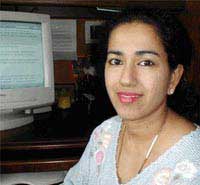Arts
Author Speak

Interview with Shoba Narayan, author of Monsoon Diary.
|
With disarming candor, Shobha Narayan says she doesn’t think of herself as a born writer. “Oh I wrote the odd poem as a school girl and published a few “middles” in the Madras edition of the Indian Express when I was in college,” she reveals.” But I honestly did not think of myself as a writer.” Author of the engaging and colorful food memoir, “Monsoon Diary,” Narayan discovered the world of writing when she enrolled in the graduate program at the Columbia School of Journalism. “I actually wanted a degree in acupuncture, “Narayan recollects. “But my husband wanted me to joinº Columbia. So I sent an application out to study acupuncture and my husband sent out an application to Columbia. The acupuncture application was rejected but I got accepted into the Columbia program, and that became my springboard into the world of writing.” The one-year intensive program not only honed her writing skills, it also opened up a world of contacts in the publishing world. After getting her master’s degree, Narayan had plans to become a hardworking reporter in a New York paper but the prospect of motherhood put paid to that plan. “My pregnancy was the reason why I decided to become a freelance writer,” she declares. “In fact, I’ve never held a full time job.”
With two daughters, Ranjini, 6, and Malini, 18 months, Narayan is a full time mother with a flourishing freelance writing career in New York city. Her articles have been published in mainstream magazines such as, Gourmet, Saveur, Food & Wine, Travel & Leisure, and The New York Times. In 1999, Narayan sent in a 150-word essay to a competition in the food section of The New York Times. The topic of the essay was to describe an occasion when the author cooked a memorable meal. Narayan’s essay on how she made a typical South Indian vegetarian meal to convince her family to allow her to go to the US and study, was chosen by the then editor Ruth Reichl as the winner. When Reichl went on to become the editor of Gourmet magazine, she asked Narayan to convert that essay into a 2,500 word article and that article then went on to win the 2001 M.F.K. Fisher Award for Distinguished writing. “When I went to the awards ceremony, I was expecting my second daughter, “Narayan remembers. “I felt like a monk in the middle of an orgy. There was wine and lots of wonderful creations by the top chefs in the country but I couldn’t eat a thing.” That same month Narayan’s agent informed her that Random house had accepted her proposal to write a food memoir. It was not her first choice for a book. “I had been working on a novel for five years,” Narayan admits. “But it never took off and I finally had to accept that that was not where my strength lay.” Writing “Monsoon Diary,” took Narayan a year to finish. “I handed in my manuscript and delivered my baby last year.” she laughs. The title was suggested by her editor and Narayan says she fell in love with it. She visited India four times during the course of writing the book to conduct her research. “Although one does remember things from childhood, to actually revisit those old spots awakens all sorts of forgotten memories,” she says. Writing the book was a good discipline for her, Narayan states, because it gave her stamina and discipline to sit and write every day, “even on the days when there is no inspiration.” Working on the book also helped Narayan ‘s parenting skills. “My husband and I have a rule never to argue in front of our children. We don’t want them to be left with unpleasant memories. But what I learnt from writing this book was that children remember only the pleasant times. My family has had its share of disagreements but when I sat down to write about my childhood, what came back was all the laughter and the joyful times we shared as a family.” Her favourite Indian snack is samosa and when she is not in the kitchen concoting rasam which she admits “to making very often,” Narayan works on her next project, a first person account of the eternal immigrant dilemma of leaving one’s homeland andº yet being unable to leave it on an emotional level. Narayan says the Indian couples in her group invariably bring up the old debate about should one go back and live in India.º “Raising kids in America is tough,” Narayan points out. “For instance, if I have to go out somewhere, I have to first find a babysitter. In India, I would have just dropped my children with a relative. ” She strives to keep the idea of India alive in her home by the using sights, sounds and scents. “Iº surrounded them with silks and sandalwood and take them once a month to meet with friends where we listen and sing Carnatic music.” Nevertheless, eldest daughter Ranjini prefers pasta to Indian food but does love Maggi noodles. Other parents among her circle of Indian friends also face similar issues and listening to their discussions sparked Narayan to think about writing about their doubts and opinions. “This is my mileu. This is what I want to write about,” she adds. As her essays and food memoir has proved, writing about what one knows is the surest way to succeed.
|

